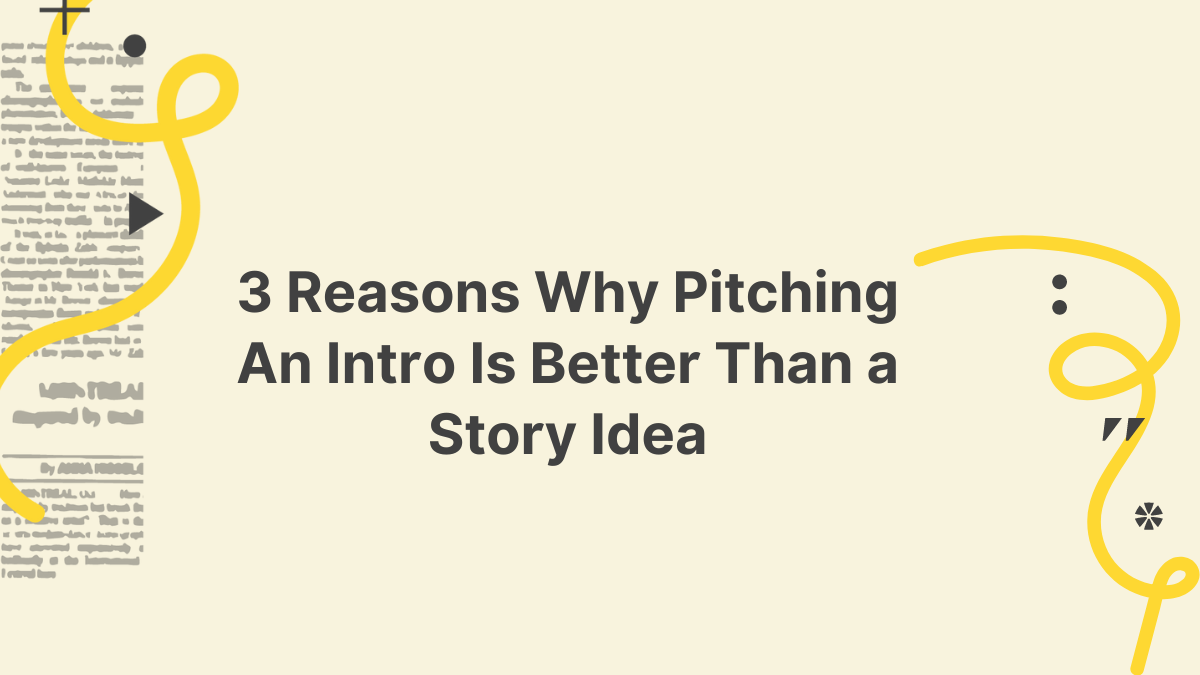3 Reasons Why Pitching An Intro Is Better Than a Story Idea

More often than not, you’ll hear from novice and seasoned PRos alike that your best bet when working with reporters is to present a well-researched, thought out, and data-backed story idea that’s relevant to their coverage.
While this is absolutely true and the case for a lot of folks, today, we’re presenting three reasons why taking a slightly different approach might help you score coverage and build awareness for your client.
By the way, don’t let the title fool you! Over here, we fully understand how important it is to connect with reporters when you have a fully-baked story idea. We’re presenting another view that maybe you hadn’t yet considered as a strategy in your pitching toolkit.
Reason 1: Start A Relationship Off On the Right Foot
Bill Conallen, public relations specialist at the Philadelphia Corporation for Aging, notes that starting with an introduction helps initiate “a relationship rather than immediately asking for something.”
By starting with an introduction, you're initiating a relationship rather than immediately asking for something. In the process, you open the door for them to explore potential collaborations, access to experts, or information that could benefit their future work.
— Bill Conallen (@BConallen) May 2, 2024
This demonstrates respect for the journalist's time and expertise, and shows a genuine interest in establishing a mutually beneficial connection. By prioritizing relationship-building over transactional interactions, you lay the groundwork for more meaningful engagements in the future, like expert commentary opps, panel invitations, or collaborative projects.
Investing in relationships with journalists can pay long-term dividends for your clients and your professional network, which leads us perfectly into reason #2.
Reason 2: Nurture A Relationship
In the words of our Pitch Posse member Hollis Guerra, senior vice president of strategic partnerships at DBC Brand Communications, “public relations boils down to relationships.” Reaching out with an intro can be a great way to nurture a relationship because “to truly benefit your clients or company, it’s crucial to cultivate genuine connections with journalists.”
Pitching your intro shouldn’t be something that reads as “Hi, I have [CLIENT] who can speak on [TOPIC]. What are you working on right now?” as this feels disingenuous and like it could have been sent to 20 different folks without consideration for their beat.
Instead, try structuring your email like the below, which keeps the relationship a bit more at the forefront. Note, this is just inspiration - you’ll want to be sure to add your own flair and pertinent information!
Hi [REPORTER NAME],
Hope you’re well. I’ve been enjoying following your coverage on [TOPIC THEY COVER], particularly [GET MORE SPECIFIC HERE TO DEMONSTRATE A KNOWLEDGE OF THEIR WORK].
I’m reaching out today to put [CLIENT/EXEC/BRAND] on your radar for your continued coverage of [TOPIC]. [NAME] is a [TITLE] with expertise in [AREAS THEY CAN SPEAK TO]. [NAME]’s perspective could support or reinforce any upcoming coverage you have on the topics below:
-
-
- Topic 1: Structure this like a media headline. You want these to be hyper-specific and tailored to their coverage.
-
-
-
- Topic 2: Same as above.
-
-
-
- Topic 3: Same as above.
-
I’ll drop more details on [NAME]’s expertise below my signature line, and in the meantime, wanted to know if there was any upcoming coverage you needed sources for. If not, no worries, I’ll make a note to keep in touch with you ongoing and share continued updates from [CLIENT] that might be of interest based on your coverage. Thanks, [REPORTER NAME]!
Building rapport early on lays the foundation for future collaborations and increases the likelihood of your pitches being considered. It's about fostering trust and establishing yourself as a reliable source, rather than just another pitch in a sea of countless others.
While a well-researched story idea is undoubtedly important, don't underestimate the power of personal connection in media relations. Hollis adds that “while landing coverage is gratifying, nurturing ongoing relationships with the press by recognizing their humanity and professional duties is even more rewarding.” We couldn’t agree more!
Hollis had another nugget of wisdom to share on how to nurture meaningful relationships, which is that “taking the time to learn about [a reporter’s] interests and beats” helps you “position yourself to offer valuable resources and story ideas down the line.”
How to do this? Engage! Hollis notes that whether you’re keeping up “with their articles, interacting on platforms like LinkedIn or X, or simply reaching out to introduce yourself when a new reporter joins the scene, understanding the people behind the bylines is key.”
Reason 3: Enhance Receptivity and Customization
Initiating communication with an introduction rather than immediately pitching a fully formed story idea might also help you increase the likelihood of the journalist being receptive to your message.
As we know, journalists are often bombarded with pitches throughout the day. A personalized introduction stands out among the noise by allowing you to show your interest in their work and expertise.
Starting with an introduction also provides an opportunity for customization. You can gauge the journalist's interests and preferences, allowing you to tailor your subsequent pitches to align more closely with their needs and current coverage focus.
This not only increases the chances of your pitch being considered but is also indicative of your commitment to delivering value to the journalist and your client.
Whether it’s your first time pitching an introduction or your hundredth, there are key factors to keep in mind when reaching out that can help you get responses, boost your chances of coverage, and most importantly, build resourceful and mutually beneficial relationships with your key reporters.
______
For more blogs like this on the nuances of public relations execution, keep an eye on The TypeBar for new insight weekly, and sign up below to stay up to date with our newsletter:
